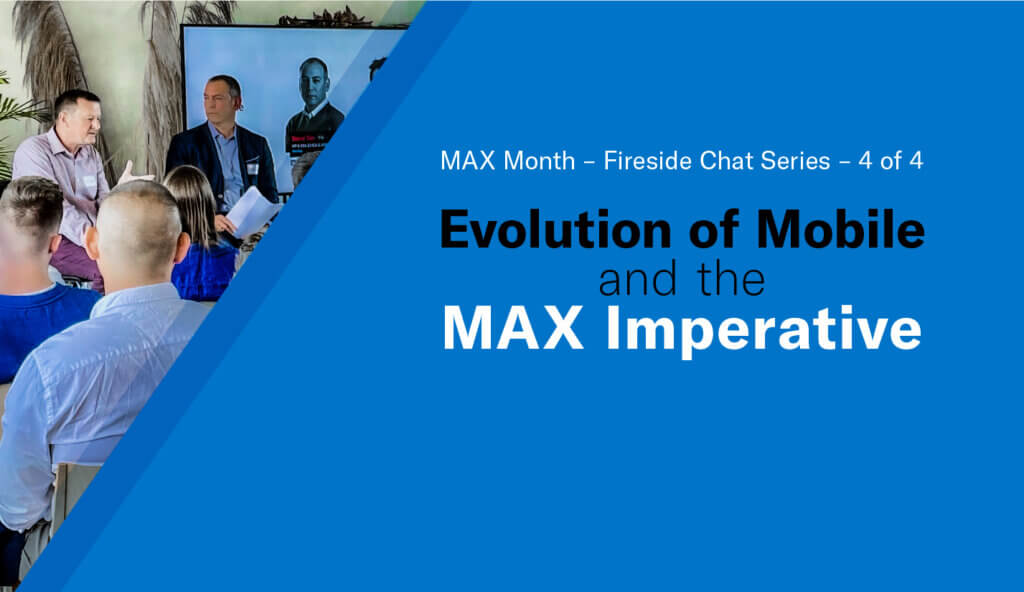Evolution of Mobile and the MAX Imperative: Seizing Opportunity – Part IV of a multi-part blog series

Steve Tan VP and General Manager, EMEA & APAC, Airship

Share to my network
In this article
Categories
Book a meeting
Connect with our team of experts to discuss your conversion and loyalty goals, and how we can help you achieve them faster.
Get a demoDavid Murphy, Editorial Director & Co-founder at Mobile Marketing Magazine and co-founder of Masterclassing, spoke with Airship’s Steve Tan at the Closing Celebration of Airship’s MAX Month in London on June 29, 2022.
In Part I, David discussed the origins of mobile marketing and how it has changed over the last few years. In Part II, he cited brands that have been most successful recently delivering MAX and identified areas of MAX in which brands are lagging. In Part III, David described his personal experience – and exchange of value – with several apps. In Part IV, he summarizes the opportunities available through data, personalization and mobile app experience
Steve: Do you see any particular trends in the market that might be seen as a challenge to brands that are trying to deliver better MAX?
David: I can only speculate, but I would mention a couple of things:
First, does the brand really want to deliver a differentiated experience for each of its users? Is there a willingness to get your hands dirty and make it happen? This stuff isn’t necessarily easy. Yes, there are companies like Airship that can do a lot of the heavy lifting. But it’s like anything in life. Your friends can tell you to exercise more or drink less, but it doesn’t happen until you decide for yourself you want to change. The momentum to deliver a personalized experience has to start with the brand.
Second, however keen the brand might be, do they have the tools and the ingredients they need to cook up this personalization recipe? Tools can be brought in. But when it comes to the ingredients, it’s largely about data. Can you convince your app users to share their personal data with you? Can you be open and transparent in leveling with your users and telling them what personal data you want to collect, and why, and what’s in it for them?
And then, are there other ways of getting that data? A company that does a lot of events with us has a gamification platform that enables brands to create gamified experiences for consumers that they can enjoy, in return for sharing their name and email, all in a proper, opted-in, consent-seeking basis. There are lots of ways that brands can try to get more first-party data, such as in-app surveys, on-pack promotions and competitions, but again, the willingness to do the hard work has to be there.
Steve: Since brands started working towards delivering better mobile app experiences to customers, what have you seen emerging in the industry as key benefits for those brands?
David: If I may, I’ll quote a couple of things that your own Chief Strategy and Marketing Officer, Tom Butta, told me when I interviewed him a few weeks ago. Your own figures show that on average, app users produce 3.5x more revenue than non-app users and are 3x more likely to make a repeat purchase than non-app users. So, if you’re looking for benefits, those are two that go straight to the bottom line.
More generally, we’ve all seen enough stats to know that people spend a lot of time each day on mobile, and I think the last figure I saw was that about 80-85 percent of that is spent in apps. We all know this, because we are all, apart from working in this great industry, consumers first and foremost.
There’s a massive opportunity here, because whatever you think the mobile demographic might be, the truth is, it’s just about everyone. When COVID hit, we all became more mobile and more digital overnight, finding new ways to communicate and buy things without going near a shop or a pub or a café, because we weren’t allowed to.
When things started opening up again, you could go to a pub for a meal and a drink, but you couldn’t go to the bar and order it. You had to scan this thing called a QR Code, and then you could order via the pub’s app or website, and then you probably had to load a credit card onto your phone to pay for it. A lot of people – technophobes, older people – were forced to learn new ways of doing things, often involving an app, that they are never going to forget.
Steve: For the brands in the room that may still be treating their mobile app as a promotional channel, how would you recommend they start working towards delivering mobile app experiences that matter to their customers? And who in their companies should be involved in that process?
David: In terms of who, I think it clearly starts at the top. Otherwise, how does the Customer Engagement Manager or the Data Strategist get the buy-in and the budget to spend with a company like Airship to make those wonderful customer experiences a reality?
They could look at churn rates. I saw some figures recently suggesting that half of all apps are uninstalled within the first month of being installed. Think about that for a moment.
The average app’s retention rate is around 20% after the first 24 hours, 7.5% after 10 days and less than 2% after 90 days. You have to ask yourself why this is. To me, it seems obvious that it’s about the app’s approach to engagement. Are you taking things carefully, one step at a time, or do you ask for every permission the app might ever need the first time someone opens it up so you can start selling them stuff? Apart from the in-store experience of a customer engaging with an employee to ask where they can find olive oil or tomato soup, an app is one of the most direct relationships a brand can ever hope to have with a consumer, so to abuse that privileged position and just treat it as a sales tool is not a good idea.
I would also say, start thinking about how you can use every interaction with a customer on the app, and ideally in other channels, to build on the next one. Last week, a customer bought a tennis racket from your website or one of your physical stores. Can you feed that into your next comms with them in the app to surface tennis shoes or balls or whatever it might be? And if you can’t, can you start to investigate why you can’t and what you would need to do and how much you would need to spend to be able to. If you did that, can you forecast with a reasonable degree of accuracy the impact it would have on revenues so that, yes, that project will cost $1M, but we believe it will deliver $10M of incremental revenues. Then the boss might just take the whole thing a bit more seriously.